UK Uncut Protest Boots Tax Scam
Boots, Oxford St, London,. 30 Jan 2011
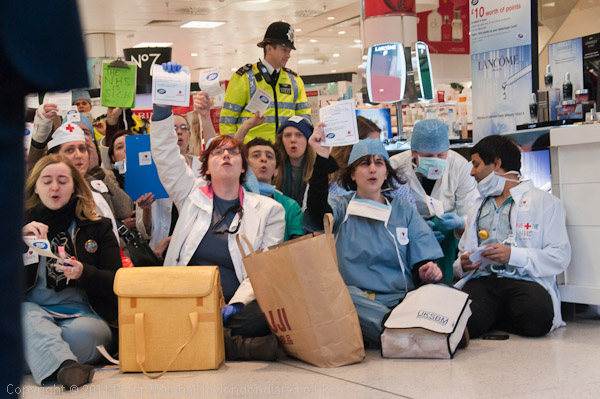
UK Unuct protestest in Boots store hold up leaflets demanding Boots pay their
fair share of tax & save the NHS
more pictures
UK Uncut activists dressed as doctors and nurses a staged a peaceful protest in Boots in Oxford St against their avoidance of UK tax, closing the store. Around 50 activists entered the store but some were rapidly evicted by security staff (who refused me entrance) and police. The remaining group demonstrated inside the store for around 30 minutes, wearing surgical masks and bandages.
Boots trades in this country selling goods to British taxpayers and it makes products in this country but has moved its business address abroad to avoid paying tens of millions of pounds in UK tax. UK Uncut say that if companies like this paid tax fairly we would be able to afford a well-funded health service and avoid cuts.
The PCS, whose members include many of those who work in the tax offices and other civil servants had estimated that tax avoidance such as this and tax evasion amounts to around £120 billion a year. So far the government has failed to take action over this - and has actually cut down on staff who investigate tax evasion.
Clearly we need a fair tax system and one that involves greater transparency over the accounts of companies and results in them paying taxes in the UK that reflect the business that they do here rather than allowing them to evade taxes by registration in countries where the taxes are lower. If you earn it here it should be taxed here seems a relatively simple and fair concept that it should not be beyond the wit of government to state and enforce.
Boots let customers leave and then closed the shop, and later we were treated to the curious sight of protesters sitting down in front of the doors because the security staff had locked them and they were unable to leave, prolonging the closure of the shop.
The protesters then sat down outside the shop and continued their peaceful protest. I left shortly before it was due to end to photograph elsewhere and missed an incident of what seems to have been unnecessary and unprovoked police violence. Up to that time I left the police seemed to have been acting correctly both towards protesters and onlookers, although I did photograph one woman being ejected with rather more force than seemed necessary. But apparently as they were leaving one of the protesters attempted to push a leaflet though the closed door of Boots which explained the reasons for the action. She was grabbed and arrested for "criminal damage" and a number of people went to help her. Police then used CS spray on ten of the protesters.
Apparently the Boots staff were appalled at what had happened and immediately offered those suffering from the spray free treatment, but three still needed hospital treatment.
The Central London action was one of more than 30 similar protests taking
place today, just before the 31 January deadline for individuals to make their
annual tax returns, in towns and cities across the UK including Aberdeen,
Birmingham, Brighton, Derby, Dundee, Edinburgh, Leeds, Liverpool, Manchester,
Newcastle, Southport and Plymouth.
more pictures
Shia Muslims 30th Arbaeen Procession
Marble Arch, London. 30 Jan 2011
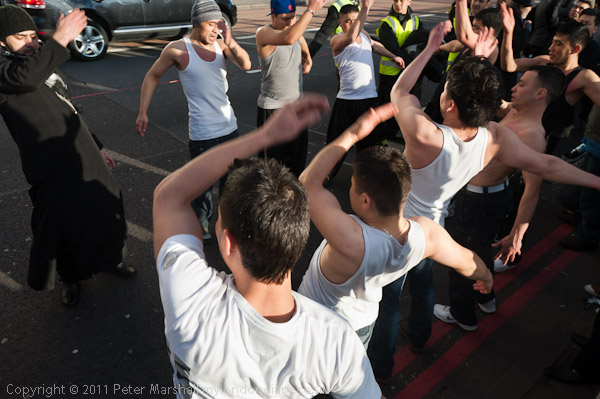
Beating of breasts in mourning on Park Lane
more pictures
Several thousand Shia Muslims came to Marble Arch today, for the 30th annual Arbaeen (Chelum) procession in London, commemorating the sacrifice made by the grandson of Mohammed, Imam Husain, killed with his family and companions at Kerbala in 680AD. Arbaeen takes place 40 days after Ashura, the day commemorating the martyrdom and marks the end of the traditional 40 days of mourning. After prayers and recitations they paraded along Park Lane in a ceremony of mourning.
Imam Husain is seen by Shia Muslims as making a great stand against the oppression of a tyrant and representing the forces of good against evil. Husain and his small group of supporters were hugely outnumbered but chose to fight to the death for their beliefs rather than to compromise. Their stand is a symbol of freedom and dignity, and an aspiration to people and nations to strive for freedom, justice and equality.
Arbaeen is also said to commemorate the return of the wives and families of those killed - who were marched away as captives to Damascus after the massacre - to Kerbala mourn the dead after their release around a year later.
Millions now attend the annual Arbaeen event in Kerbala (though it was banned while Saddam Hussein was in power) and the London event attracts Muslims from all over the UK, although numbers this year seemed rather fewer than in some previous years.
The Hussaini Islamic Trust UK first organised this annual procession since 1982, making it the oldest Arbaeen/Chelum Procession of Imam Husain in the west. It was the first annual Muslim procession in Central London and is still one of the larger annual Muslim processions in the UK. It is held on the Sunday closest to Arbaeen.
The procession includes several large replicas of the shrines of Karbala; known as Shabbih, these gold and silver models are over 10 feet high and the largest in Europe. There was also a decorated and blood-stained white horse or Zuljana representing the horse of Imam Husain, a cradle remembering his 6 month old child Hazrat Ali Asghar who was also murdered and a coffin.
The day started at Marble Arch with prayers and recitation which were followed by speeches in English, Arabic and Urdu before the procession set off. I missed some of this as I was busy covering another event, but returned shortly after the procession set off down Park Lane.
Groups among the men chanted and all those marching beat their chests as a token of mourning, most in a symbolic rather than very physical manner, but as the procession made its way down the road some were soon stripped to the waist and beating themselves vigorously, producing red marks and some drawing blood.
The women marched in a tightly packed separate group at the rear of the march, held back by a number of women stewards and pushing the cradle and one of the Shabbih. Like the men they chanted and made gestures of mourning. Although they were almost all dressed in black, many of them were carrying standards and flags, and some had some brightly coloured embroidery and headscarves.
After the march there are light refreshments provided, but I left before
that, catching a bus along Park Lane. The procession only occupies one of
the three lanes of each of the dual carriageways and traffic keeps flowing
throughout, although with some slight delays.
more pictures
No Fees, No Cuts! Student March
London. Sat 29 Jan 2011
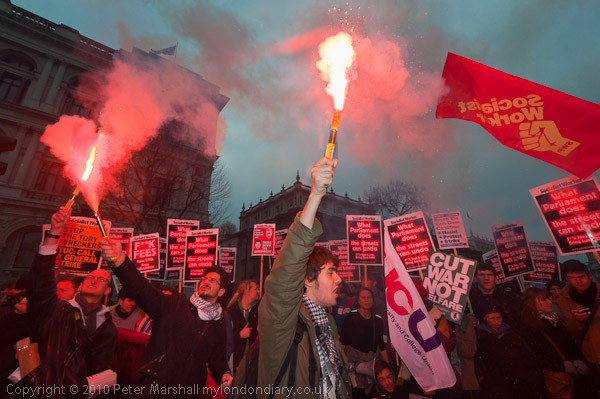
Flares at Downing St
more pictures
Thousands of students, teachers, parents and others marched peacefully through London today in the latest demonstration to defend education and the public sector. The demonstration, backed by the National Campaign Against Fees and Cuts was one of two national marches today, with another taking place in Manchester.
Again police gave out a leaflet to marchers, with a clear map showing the official route and describing how the march would be policed. It told them, for example, that they could expect to see large numbers of police protecting some key buildings such as Downing St, as well as police at road junctions. The largest concentration of police was however at Millbank, which police had left the Conservative HQ almost completely unprotected for the first of these protests in November - with rather predictable results.
Police do seem to have learnt lessons after their mistakes last year, and I saw no real problems arising today. Despite the number of protesters in anarchist dress with facemasks, most students are not out to cause trouble. But if police start pushing people around, or kettling them, problems are going to arise.
The march had started early, following a brief rally in Malet St, and by the time I arrived the front was making its way out of Russell Square, but there was no sign of an end. Altogether there were perhaps 5,000 taking part.
Small groups of protesters stopped at Topshop and Vodaphone shops in the Strand and protested about their tax avoidance. Police soon came and persuaded the students to move on. Opposite Downing Street the march paused and several bright orange flares were lit at the front of the march.
Some of the students also stopped in Parliament Square for some time, and a samba band provided music for some dancing; the mood was upbeat and there was no trouble, and after a while everyone moved off and made there way to the end of the march on the Embankment by Tate Britain. By the time I arrived with the tail end of the marchers, there was no sign of the rally there, which had presumably finished.
At one point outside the Millbank tower complex, police wanted to drive a couple of vans of reinforcement through a crowd, and some people sat down on the street. Police asked them to move but met with no cooperation. Rather than try and force the issue, police just formed a line so that the two vans could bypass the seated students and drive along the pavement. It was a simple solution that avoided further friction. Later there were reports of half a dozen people arrested in minor incidents.
Some of those on the march were planning to go on to protest elsewhere, including
Oxford Street and the Egyptian Embassy, but I decided to go home.
more pictures
Solidarity with the Egyptian Revolution
Egyptian Embassy, South St, London. Sat 29 Jan 2011
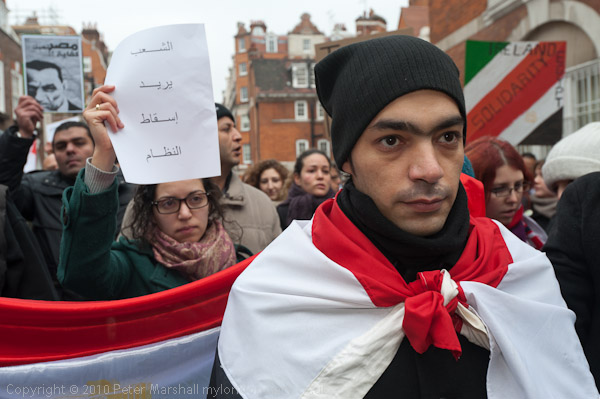
Protester wearing Egyptian flag opposite the Embassy
more pictures
A couple of hundred people, many of them Egyptians living in the UK from differing political & ideological backgrounds held a peaceful but noisy protest
"to show our solidarity & support of our fellow Egyptians in our beloved country, who decided on making Tuesday 25/01/2011 a day of protests & demonstrations in Egypt against the unfair, tyrant, oppressive & corrupt Egyptian regime that has been ruling our country for decades."
Their statement continued:
"We would like to announce our full solidarity with all honourable freedom fighters from different backgrounds who decided to peacefully protest (despite the expected suppression & brutality from the regime) in order to achieve our justified goal of a democratic, free & civil nation capable of ensuring a dignified, honourable & non-discriminatory life for all Egyptians."
"We are inviting all supporters of human rights & civic democracy to come & support us in delivering our message to the Egyptian regime."
The organisers had posted the above details in Arabic and English on Facebook
and asked people to "spread the word & invite your friends."
It was unfortunate that this event was at the same time as national demonstrations
over student fees and cuts in both London and Manchester, or rather more people
would have attended, and I had to leave rather early.
more pictures
Hizb ut-Tahrir Turned Away
South Audley St, London. Sat 29 Jan 2011
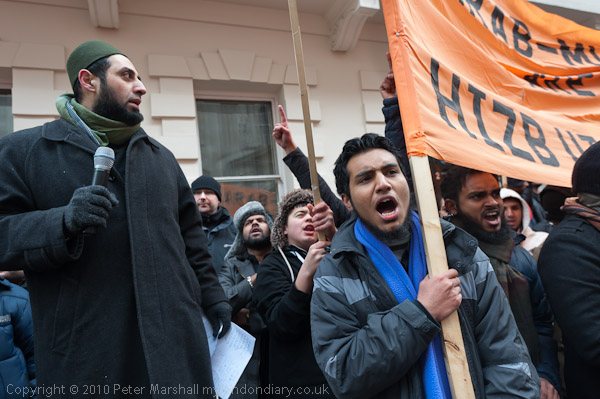
The speaker pauses while the crowd chants slogans
more pictures
Hizb ut-Tahrir, an Islamist group calling for the establishment
of a Muslim caliphate, had to protest along nearby South Audley St, after
Egyptians refused to allow them to join their solidarity protest opposite
the Egyptian embassy.
Hizb Ut-Tahrir Britain arrived to take part in an emergency picket at the
Egyptian Embassy, but there they met a group of Egyptians "from different
political & ideological backgrounds" (see above) who were already
present and holding a peaceful protest to "solidarity & support of
our fellow Egyptians in our beloved country" who have been protesting
in Egypt since Tuesday. Hizb Ut-Tahrir were apparently told very firmly that
the embassy protest - like the Egyptian revolution - was to be entirely non-sectarian
and that they were not welcome there.
So Hizb ut-Tahrir were forced instead to hold their own separate demonstration around a hundred yards away around the corner along South Audley St, where they were spread out along the pavement between South Street and Hill Street. As always at their events, everyone was dressed in black and the men and women were segregated. The men filled most of the pavement along South Audley St, with just a few women at one end, with most of them around the corner eastwards on South Street, away from the loundspeakers and the embassy. It seemed a clear demonstration of the lack of equality they would like to impose.
While I was there none of the speeches were in English, though I could pick out the occasional word. But as always they were calling for the establishment of a Muslim Khilafah (caliphate), the "real change" which they see as the answer to everything.
Most Egyptians want to get rid of what they feel is an oppressive regime and want a free and democratic nation, a secular state where there is no discrimination based on gender, religion or political views. They find the idea of a caliphate as oppresive as the present corrupt regime.
Hizb Ut-Tahrir Britain had been planning to demonstrate later in the day
a short distance away outside the Hilton Hotel in Park Lane against the "two
years Fascist Rule" by the Hasina Government in Bangladesh. Although
many might agree with their complaints about the arrests, detention without
trial and attacks on the opposition there, there are probably few who would
find living under the kind of Islamic Khalifah they propose a welcome alternative.
more pictures
Release Binayak Sen Now
Indian High Commission, Aldwych, London. Wed 26 Jan 2011
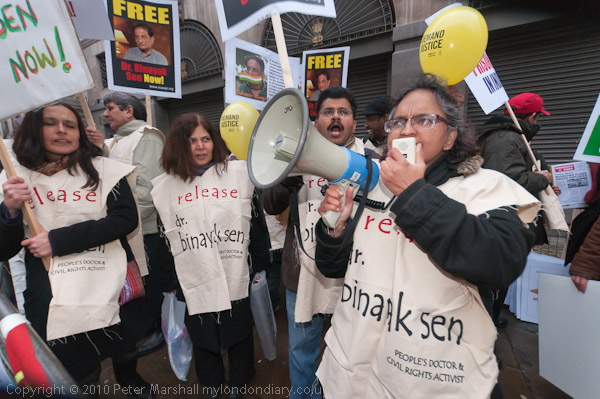
Protesters in bibs outside the Indian High Commission
more pictures
Protesters outside the Indian High Commission on India's Republic day called for the immediate release of people's doctor and civil rights activist Dr Binayak Sen, and for the reform of the corrupt Indian justice system.
Dr Binayak Sen has been widely recognised for his work as a doctor working with indigenous and marginalised people, reciving the Paul Harrison Award from the Christian Medical College where he had studied in Vellore for his lifetime service of the rural poor in 2004, the R R Keithan Gold Medal of the Indian Academy of Social Sciences in 2007 and the Jonathan Mann Award for Global Health and Human Rights in 2008.
The Global Health Council is a US based non-profit organisation whose membership includes health-care professionals, NGOs, foundations, corporations, government agencies and academic institutions dedicated to saving lives by improving health throughout the world. It makes its awards to those it considers "the world's most dedicated advocates for improving the human condition" and Sen gained his for his work in Chhattisgarh, India, where he "helped establish a hospital serving poor mine workers in the region, founded a health and human rights organization that supports community health workers in 20 villages, and is an officer of the People's Union for Civil Liberties (PUCL)."
Dr Sen criticised the state Governmetn's atrocities against indigenous people fighting the handover of their lands for mining and their establishment of an armed militia, the Salwa Judum, to fight against the Naxalite (Maoist) rebels in the area.
He was arrested in May 2007 and accused of having links with the Naxalities. There was a public outcry against his arrest with demonstrations and publicity around the world calling for his release. In August 2007 further charges were brought under the Chhattisgarh Special Public Security Act and the Unlawful Activities (Prevention) Act. His trial began in May 2008, and in May 2009 he was granted bail because of his deteriorating heart condition.
On 24 December 2010, Dr Sen was found guilty under the two acts mentioned and of sedition and conspiracy under the Indian Penal Code and sentenced to life imprisonment and was immediately jailed. He has again applied for bail, and in a hearing on 24 Jan 2011 his lawyer "described the trial court verdict as one based only on police versions." The hearing continues on Feb 9.
I arrived as the event, called by Release Binayak Sen Now Campaign and supported by Amnesty International and other groups including the International Campaign Against War on the People in India, the South Asia Solidarity Group and Indian Workers Association, was just starting and more people were still arriving after I left.
The protesters wore bibs with the clear message 'Release Dr Binayak Sen,
People's Doctor & Civil Rights Activist' and as well as placards and banners
some had yellow Amnesty International balloons with the message 'I Demand
Justice'; as well as demanding the immediate relase of Dr Binayak Sen, they
were also calling for a drastic reform of the shamefully corrupt Indian criminal
justice system to prevent it being "manipulated by the state to persecute,
prosecute and victimise innocent persons." Others were more blunt, with
placards calling for an end to "the genocidal state war on people of
India" and for the freeing of all political prisoners in India.
more pictures
Free Kashmir & Khalistan
Indian High Commission, Aldwych, London. Wed 26 Jan 2011

Sikhs call for their own state, Khalistan
more pictures
Kashmiris and Sikhs held a protest together outside the Indian High Commision on Republic Day, the 61st anniversary of the Indian Constitution, calling for the freedom that their nations have been denied by Indian military repression.
The protest was called by the All Parties International Kashmir Coordination Committee, along with the Council of Khalistan and Dal Khalsa and was attended by around 50-100 people. Many Sikhs and Kashmiris are said to be reluctant to take part in demonstrations at the High Commission, fearing that it might prevent them from obtaining visas to return to Kashmir or India to visit relatives.
Kashmir, a country since the Iron Age, became a Muslim monarchy in 1349, but became a part of the Sikh Empire in the nineteenth century, and then was established as a kingdom under British guidance. At partition in 1947, following an invasion by Pakistan, the ruling Maharajah ceded the kingdom to India. Since then there have been UN declarations and Indo-Pakistan wars and the country remains under a heavy military presence divided between India and Pakistan (and with a smaller area under Chinese rule.)
Many of the Kashmiris in the protest held placards remembering Kashmiri freedom campaigners - mainly Muslims who make up around 80% of the population - killed by the Indian military, who have carried out reprisals against the Kashmiri population and imprisoning and torturing them. Some of the attacks supposedly carried out by freedom campaigners and Muslims are alleged to have been carried out by Hindu radical groups which include Indian military personnel.
Although overall Kashmir is largely Muslim, there are significant Hindu and smaller Sikh and Buddhist minorities. The protesters today calling for a free Kashmir insist that their movement is not against these minorities and that they have never targeted them. They claim - and many independent reporters have supported them - that the incidents that have taken place - and some on a very large scale - have been encouraged by India as a way to discredit their independence movement.
Feelings are running high in Kashmir at the moment due to a march by the Hindu nationalist Bharatiya Janata Party (BJP), to Srinagar, the state capital and raise the Indian national flag there in a special rally. Both the state government and the Indian government appealed to the BJP to call off this provocative march, and a number of BJP leaders have been arrested.
Both India and Pakistan have been found by UN bodies and other investigations to be guilty of widespread human rights abuses in the areas of Kashmir they adminster. The UN in 1948 called for the people of Kashmir to be allowed to determine their future by a free and fair vote, but this has never been possible due to the opposition of both India and Pakistan. India held elections in the area under its control in 1951 and created an assembly which ratified the inclusion of Kashmir in India in 1954. China occupied part of the country in the 1950s, and Pakistan ceded a border area to them in 1963. Pakistan has continued to press for a vote across the country to decide its future, and as well as the two wars between the two countries, and has trained and supported Kashmiri militants.
Sikhs began to call more vigourously for their own homeland following the attack by the Indian Army on the Golden temple at Amritsar, and the widespread anti-Sikh riots and killing which followed the assassination of Prime Minister Indira Gandhi by her Sikh bodyguards in 1984. On 26 January 1986, exactly 25 years ago today, the Sikh national body, the Sarbat Khalsa decided to establish a sovereign independent Sikh state of Khalistan.
Since then, Sikhs have been subjected to "various military and political
manoeuvres to engineer the reverse of that peaceable and lawful response to
the 19894 genocide" and as in Kashmir there have been widespread human
rights abuses.
more pictures
Save the BBC World Service
Bush House, Aldwych, London. Wednesday 26 Jan 2011
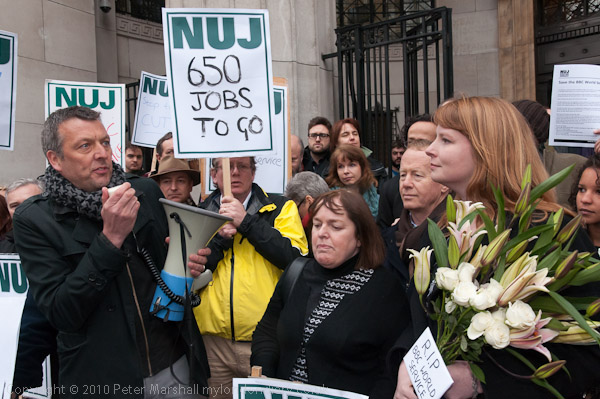
Jeremy Dear, NUJ General Secretary speaking at the protest.
more pictures
The NUJ organised a demonstration against the savage cuts announced by the BBC for the World Service broadcasting, with up to 650 job losses, switching off of radio services and the complete loss of services in 5 languages.
More than a hundred NUJ members and others came to the demonstration outside Bush House, the home of the BBC World Service at Aldwych this lunchtime. Some carried flowers which they hope the management will not remove from the front of the building to express their opposition.
The BBC World Service reports on events around the world, with listeners in many countries. Its radio services in particular reach into the rural areas of many, many countries, often being regarded as providing a more reliable news service than any indigenous offerings.
In terms of trust, the BBC World Service must be the leading brand worldwide, and one that could be even more important and influential in the future. But the BBC has decided to cut it back hard, perhaps as a deliberate but short-sighted response to the government's stance over the licence fee. The nation deserves better treatment and a more responsible attitude. We could live with one less comedy series that could be done equally as well by commercial providers or sporting events that would be covered almost as well by them, but the BBC World Service is unique. It has a well-deserved reputation as the best in the world and should be the BBC's priority rather than being treated as a poor relation.
Jeremy Dear, NUT General Secretary, who spoke at the protest put it well. "The diversity of staff and their presence in so many key locations around the world contributes to making the BBC World Service the leading voice in international broadcasting. At its best the World Service can challenge corruption, expose human rights abuses and promote democratic values. By cutting the service the government will cut British influence in the rest of the world, and cuts will also be deeply damaging for objective quality news services around the globe."
A Facebook group has been set up to oppose the cuts appropriately named 'SOS
BBC World Service.' This truly is an emergency and if the cuts go ahead they
will seriously damage the world-wide reputation of the UK.
more pictures
Student Day of Action
Trafalgar Square,London. Wednesday 26 Jan 2011
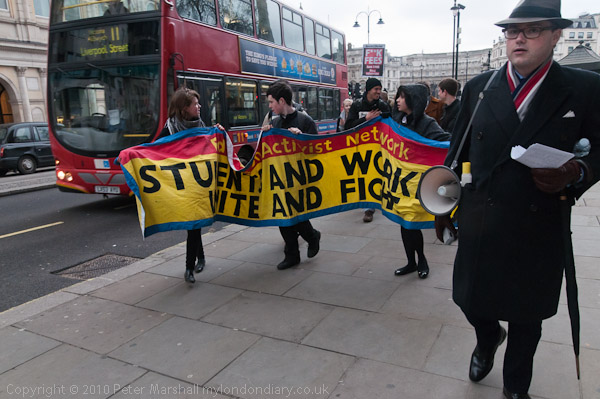 Students
march from Trafalgar Square towards the NUJ Protest
Students
march from Trafalgar Square towards the NUJ Protest
more pictures
Publicity about the student day of action called for today suggested that students walk out of their schools and colleges but it was hard to find any suggestion of what they should then do. It was hard indeed to find the call which had been made for those in London to assemble at noon in Trafalgar Square, which doubtless explains why so few turned up to hear a few short speeches there.
Two suggestions were then put to those present, that they should go and support the NUJ protest taking place outside Bush House against the drastic cuts proposed by the BBC for the World Service or join the students from Westminster Kingsway College who were to march to the Bloomsbury London University campus.
They decided to go first to the NUJ demonstration, and since it was my own
next destination I led the way up the Strand towards Aldwych. Later some of
those present intended to go to Kingsway College and to join a protest planned
at Euston for 5pm, but I left them at Bush House.
more pictures
Camden Market
Camden High St/Chalk Farm Rd, London. Monday 24 Jan 2011
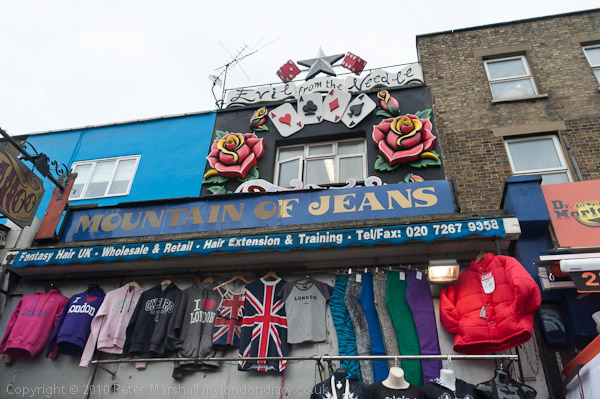
Tourist London supreme on Camden High St
more pictures
I got off the bus from Archway at Camden Town, mainly to take advantage of one of the rapidly disappearing public toilets on the streets of London in the middle of a busy road junction there. I had some time to spare and took a walk up Camden High St. It's never been a favourite place of mine, full of tat, but that has now increased to such and extent it almost become interesting.
I spent quite a lot of time photographing round here in the 90's, usually after I had finished some more serious work on a weekend afternoon, and I would get off the tube at Camden Town and walk up to Chalk Farm station, taking the opportunity to call in at Marine Ices on the way and have a lemon sorbet or whatever took my fancy. Then it was almost certainly the best ice cream in London
But it wasn't the kind of day for ice cream, and I didn't get that far, but
photographed most of the decorated upper storiey's of the shops along with
the tourists. When I first came the place would have been pretty much deserted
on a weekday,and only got down to business at the weekend, but now things
seem to go on all week.
more pictures
Atos Tests Unfair to Disabled
Archway and Triton Square, London. Monday 24 Jan 2011
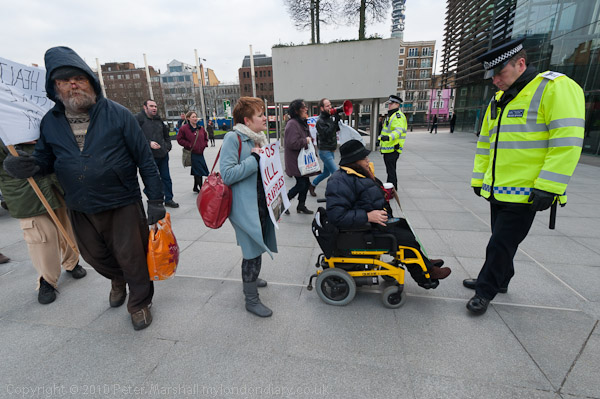
Police try rather ineffectually to stop protesters heading for the Atos offices
more pictures
Around a hundred people demonstrated in a national Day of Action outside the London HQ of Atos Origin, the company used by Job Centres to run assessments of 'ability to work' which unfairly deny benefits to the disabled.
The protest outside the offices in Triton Square, just off the Euston Road
was a part of a National Day of Protest Against Benefit Cuts, with actions
around the country, including protests in Leeds, Birmingham, Burnley, Hastings,
Crawley, Chesterfield, Livingston, near Edinburgh (Atos's Scotland HQ) and
Glasgow.
Most of these protests targeted Atos, whose healthcare division runs the recently
introduced 'work capability assessments' for the DWP's job centres, with some
also taking place outside job centres and offices of another company profiting
from the privatised provision of welfare services, A4e.
From February 2011 all those on Incapacity Benefit will be moved to Employment and Support Allowance (ESA). Under ESA claimants are usually called after around three months for an assessment by Atos Healthcare which supposedly tests their ability to work. Experience so far is that almost 70% of claimants are denied the ESA as a result of these interviews, and either have to claim the lower benefit rate of the Job Seekers Allowance, or in some cases are refused any benefits.
Atos employ healthcare professionals (HCP) - doctors, nurses or physiotherapists to carry out an assessment with the aid of a computer program, LiMA, to produce a report on the claimant. The program takes them through a series of questions and also provides set phrases to build the final report on suitability for work. Although the HCPs are given some training in using the system, many lack the qualifications and experience to assess many types of disability, particularly mental illness.
Many claimants feel that the use of LiMA leads to an impersonal approach that cannot take account of their particular circumstances. It also results in the HCP carrying out the assessment to jump to inappropriate conclusions and often tick the wrong boxes to get on to the next question, particularly as they are required to make complex assessments in a relatively short time.
An independent review by Professor Malcolm Harrington for the DWP, published in November 2010 made a number of fundamental criticisms, particularly that the Atos system fails to deal properly with mental health problems - which include more than a third of cases - and that it fails completely to recognise the effect of fluctuating conditions and the repeatability of tasks. A claimant may be able, for example to walk a specified distance, but the effort may tire them so much that they are unable to repeat this without prolonged rest - but the system only records their ability to walk the distance.
Professor Harrington also called for greater transparency, and in particular for all claimants to be given a plain English copy of the summary and be able to discuss and correct any inaccuracies with the job centre decision maker. The report states that in a Disability Benefits Consortium survey of around 600 who "had been through an Atos assessment, one half had seen their report but only 15% of those thought it was an accurate reflection of their answers at the interview." Often simple facts were incorrectly recorded. The problems raised by this official report are, as it states, reflected by the comments of many other bodies, including the Child Poverty Action Group and the Citizen's Advice Bureau as well as many claimants groups.
Further evidence of the poor quality of these assessments is the huge flood of appeals against the refusal to award ESA - around 16000 a month by the middle of last year and the success of over 40% of them. In some cases the tribunal has increased the points score of claimants dramatically - for example from 0 to 24 points (15 are needed to remain on ESA) But too often these appeals are then followed by another Atos assessment after six months which repeats the same incorrect result as before. One of the speakers at today's rally told of a friend of his who had been driven to suicide by a series of such assessment and appeals.
George Osborne in his Comprehensive Spending Review and continued statements by other members of the government continue to deliberately overstate the problems of benefit fraud - which according to the national Audit Office only amounts to 0.6% of the DWP budget. As a speaker at the rally outside Atos from the PCS branch at the nearby tax office reminded us, the cost of inflated benefit claims is a drop in the ocean compared to the losses by tax evasion by the super-rich and the amounts lost by them and major corporations exploiting tax loopholes. But the government is cutting the number of people investigating tax evasion and has yet to make any effort to prevent the huge losses through tax avoidance.
In spite of all the evidence and criticism and the clear unfairness of the Atos assessments (and the 135 Atos doctors in the Prospect union who carry them out have complained that the short time allowed will lead to many wrong decisions, particularly in complex cases) the DWP have recently announce a new contract with Atos worth £300 million to continue to continue them. Sums of this size can't be recouped by taking benefits from those who aren't in real need, but will hurt the sick who really need our help - people like Simon Powell in Hartlepool, a wheelchair user who needs 24 hour support but was declared 'fit for work' in an Atos assessment a couple of months ago, and lost his disability benefits. Over the next three years, around 1.6 million people will be tested, and hundreds of thousands will have their benefits slashed to satisfy the Atos shareholders.
Linda Burnip from Disabled People Against Cuts put it simply: "Benefit claimants are being forced into even great poverty to fuel the greed and excesses of corporations like ATOS making huge amounts of money by wrongly assessing disabled people as fit to work when they are not."
This morning around a dozen people from the Islington Poverty Action Group handed out leaflets outside the Archway Examination Centre in Elthorne Road, N19 from 11.30am, talking with those going into the adjoining Job Centre about the cuts and the problems of the assessments. Some faces of people entering and leaving the job centre have been anonymised.
Among other groups taking part in the afternoon protest Disabled People Against Cuts, WinVisible (Women with Visible and Invisible Disabilities) and London Coalition Against Poverty.
At 2pm, around 50 people met in the centre of Triton Square, a recent development of office buildings next to the Euston tower, with around 20 police and probably as many security men from this 'private' public space watching them. The police had set up a pen for the protesters well away from the Atos offices, but they decided not to carry out their protest there, and avoiding the attempts by the police to stop them, made their way to the Atos Offices.
Police formed a line to stop them entering the offices, and the protesters made no attempt to breach this, being intent on a peaceful protest. At one point an elderly man did walk through the police line, and was briefly dragged to the floor and then off to one side, but after a few minutes was allowed to rejoin the protest.
Many of those present, including most of those who were in wheelchairs took their turn in speaking to the crowd, which by this time had grown to around a hundred.
Police brought up a line of barriers to put in front of the Atos offices while the protest continued, but after a while they returned with more and began to fence the protest in. The group attempted to move back towards the square but police told them to stop and they did so. Police then told them they could only leave the pen when they wanted to end the protest and leave the area completely. Given the nature of the protest there seemed no particular reason for this, other than police pique (which I overheard one of the officers in charge expressing) that they had not originally followed the police instructions.
The protest was still continuing inside the pen when I left around 3pm.
more pictures
Hogsmill Walk
Kingston on Thames, London, Saturday 22 Jan 2011
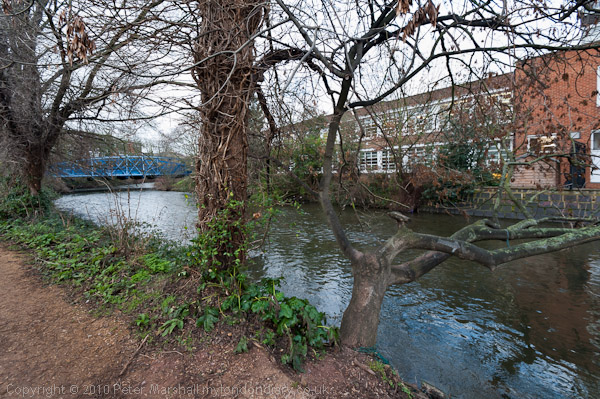
The Hogsmill at Kingston University
more pictures
After the end of the CWU march, I sat by the Thames and ate my sandwiches in a light drizzle before taking a short walk mainly beside Kingston's other river, the Hogsmill. It's a river people seldom mention when talking about the rivers of London, perhaps because until 1965 it, and Kingston, were still in Surrey rather than London.
The Hogsmill is a short river, starting from a spring around 6 miles from the Thames at Ewell, with a slightly longer tributary coming from Epsom, both still in Surrey, and running through Old and New Malden to Kingston. It has a surprising amount of water in it coming from these chalk springs on the edge of the North Downs, as well as several sewage works en route.
Quite a few walkers come along this way as it is a part of the 'London Loop',
an outer London orbital path taking around 150 miles to cover the route from
Erith to Purfleet, around a kilometre from its start point, sometimes described
as an M25 for walkers, but I saw none on this section today.
more pictures
Keep Royal Mail Public
Kingston, London. Saturday 22 Jan 2011
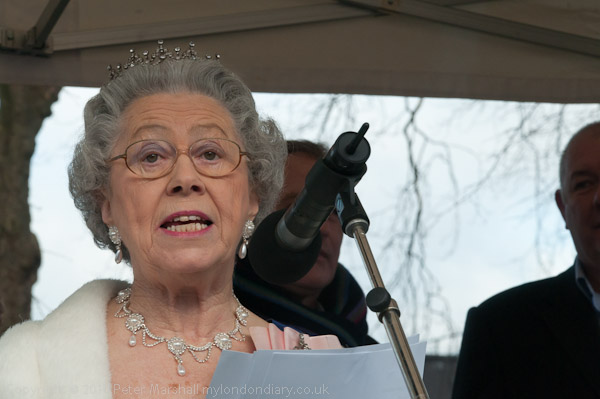
A 'royal address' against selling off the Royal Mail
more pictures
An impressive Queen lookalike made her 'royal' speech at the close of the CWU's 'Keep The Post Public' rally in Kingston, where more than a thousand marched against plans to privatise the Royal Mail.
Kingston was chosen for the protest as it is the constituency of Lib-Dem MP Edward Davey who is heading the coalition's plans to sell off our postal services. It's also a very apt location for a protest against selling off the Royal Mail, as it is a Royal Borough where many of our early English monarchs were crowned. The march following the rally passed within a few yards of the Coronation stone in front of Kingston Guildhall before ending by the River Thames.
Edward Davey is MP for Kingston & Surbiton and Minister for Employment Relations, Consumer and Postal Affairs, and before being elected as an MP was a management consultant who specialised in postal services, working on them in Sweden, Taiwan, Belgium, South Africa and elsewhere.
Business Secretary Vince Cable, Davey's boss, is the Lib-Dem MP for the neighbouring constituency, Richmond & Twickenham. So the plans to sell of the postal service very much arise from these two Lib-Dem MPs in the small area of West London where the protest took place.
The national 'Keep the Post Public' demonstration started with a rally in the Fairfield Recreation Ground in the centre of Kingston. Among the speakers were CWU general secretary Billy Hayes, Dave Ward of the CWU Postal department, local Labour candidate Max Freedman, Jim Kirwan, CWU London regional secretary, Christine Quigley of London Labour Youth and Christine Blower, the NUT General Secretary. One of the biggest rounds of applause was for Arnie, a school student who spoke briefly about how they had organised against the government cuts and fees increases and had occupied their school.
The Royal Mail is currently required to deliver and collect to all of the 28 million UK addresses six days a week at the same cost. The Postal Services Bill, currently awaiting its second reading in the House of Lords, includes a requirement for Ofcom to review the current universal service within 18 months of the sell-off. Almost certainly this would lead to them approving poorer levels of service in more remote areas and possibly differential prices, getting away from the current universal tariff, either immediately or at a later review.
The Bill also charges Ofcom with assessing the financial burden of providing the universal service, and this will almost certainly lead to large price hikes. Even without this we are getting a 5p rise in stamp prices next year.
Privatisation of the Royal Mail would also threaten post offices, as the Bill does not safeguard the 'Inter Business Agreement' that links postal services with post offices, and the privatised service could decide to use supermarkets and high street chains in preference to local post offices as their major outlets. The result of losing perhaps a third of their income would be disastrous on these local post offices, leading to thousand of them, particularly in rural areas, closing.
An ICM poll in 2009 found that 78% of us believed selling Royal Mail would be a bad deal for the taxpayer and 82% thought prices would go up. But the Royal Mail represents rich pickings for the rich supporters of the government, as it made £321 million profit in 2009 and £404 million in 2010, and has the support of both staff and management for its modernisation plans.
After the rally, the march, with many union banners set off led by some loud
drumming by a band of Indian drummers and accompanied by the jazzy brass of
the Select Syncopators, made its way through the busy shopping centre of Kingston,
with occasional brief halts and Dave Ward making good use of a powerful megaphone
to raise support.
more pictures
Students March Against EMA Vote
Piccadilly Circus to Parliament Square, London. Wed 19 Jan 2011
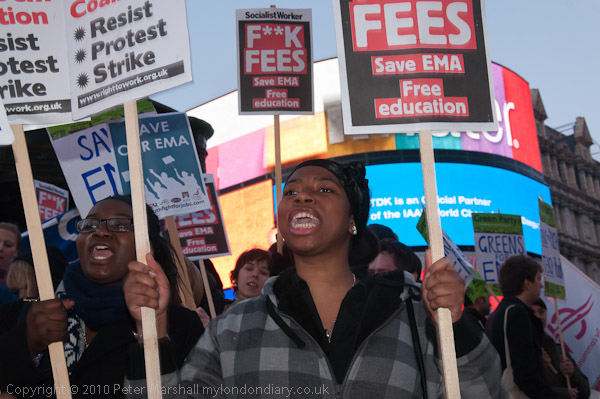
Students gathered at Piccadilly Circus for the march
more pictures
Approaching a thousand students gathered in Piccadilly Circus and marched to Parliament Square in a peaceful protest as Parliament voted today to scrap EMA payments. Students aged 16-18 have been enabled and encouraged to stay in education by the payment of a £30 a week educational maintenance allowance. The full £30 a week is available to those with a parental income of less than around £20,000.
Today parliament debated and voted on the coalition Government's proposal to scrap these allowances after the end of this academic year. They argue that the EMA costs a lot to administer and that many of those who receive it don't actually need it. Since the school leaving age is expected to be raised to 18 by 2013 in any case, it would then no longer be necessary to have an incentive to remain.
Unfortunately for him, David Cameron, when questioned on the future of the EMA before the election made it clear that his party would continue with it were they elected. One of the posters on the march showed him with a very long Pinocchio-style nose, and others accused him of lying. His is certainly the kind of behaviour that reinforces the negative feelings that many have of politicians as people who will say anything to get elected and then renege on their promises.
Students, teachers and lecturers appear united in calling for the retention of the EMA and in stressing the real hardship that scrapping it will cause for many. In rural areas many students will be unable to pay the fares to make their lengthy journeys to college, and in urban areas many will have to look to poorly paid part-time jobs which - if they can find them - will have a serious effect on their studies, and they will have to do without the extra resources and materials which are essential for some courses. Recent research by the University and College Union, representing lecturers, suggests that around 70% of students in the poorest areas of the country would drop out if their EMA was stopped.
It was hard to count the students on the march in the early evening gloom, particularly as the spread out across the street, but my rough estimate as they marched up the Embankment towards Parliament Square was around 800.
In Parliament Square there was a van with loudspeakers and a number of rappers performed from it. Others danced to a sound system on a trolley that had taken part in the march. Some students had come earlier in the day to lobby MPs - even those too young to vote at the moment will be able to do so at the next election - but few were staying until the bitter end to hear the result of the vote, and I too left shortly before the results of the vote came through, that the government had won the vote to scrap the EMA with a majority of 69.
The demonstration was generally well-ordered and free from violence. Although there was a strong police presence in central London there were none of the confrontations and large masses of police often seen at earlier events, and I saw no police horses. Perhaps following the criticism I had others had made about the failure of communication between police and protesters at earlier student demonstrations, all of those taking part today were offered a flyer written by the Met Police which gave details of the agreed route and the rally and explained the role of the police and why they would be present at road junctions and guarding some buildings.
The advice in it doubtless served as a reminder to police as well as informing the demonstrators and reminding them of some of their rights. In a paragraph about 'containment' (the police term for kettling') the document states: "Containment is used as a last resort when there is serious disorder or to prevent an imminent breach of the peace. The containment will be in place for no longer than is necessary to deal with the issue. The officers will be mindful of your welfare and they will attempt to let you know what is happening and help you get out as soon as is practical"
This is a welcome statement which in every sentence contradicts the police practice in the student demonstrations in November and December - when kettling was imposed without good reason, for a length of time that was clearly intended as a punishment and with little if any thought for the welfare of protesters. I hope it really shows a change of attitude by the Met, and a future intention to uphold "the fundamental freedoms expressed by the Human Rights Act" and to practically "respect the right to protest" which has often seemed absent in the past few years.
Today I saw no problems, and police seemed happy with the way things had
gone, but there were few challenges from the marchers who largely followed
the police directions, except for spilling over onto both sides of the road
at some points, which police sensibly largely ignored.
more pictures
UK Uncut Protest VAT Rise at Vodaphone
Vodaphone, Oxford St, London. Sat 15 Jan 2011
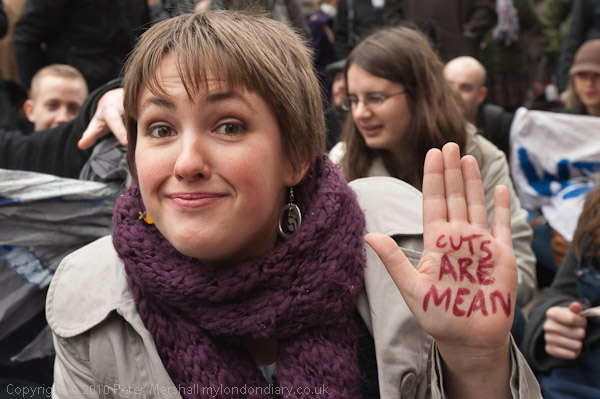
I watched this woman writing 'Cuts are mean' on her hand, sitting on the pavement
outside Vodaphone.
more pictures
Anti-cuts activists, UK Uncut, held a protest outside Vodaphone's Oxford Street store in their campaign to force the government to clamp down on tax avoidance rather than cut public services and increase the tax burden on the poor.
Around eighty activists from UK Uncut turned up outside the Vodaphone store in Oxford Street, London for a protest on Saturday afternoon against the rise in VAT from 17.5% to 20% and called on the government to take steps to stop tax dodging by rich individuals and companies such as Vodaphone.
Around 50 of them sat down on the pavement outside the store shortly after 1pm and were still there when I left an hour later. Although police and store security ensured that the was a way clear into the shop, only a handful of customers made their way past the protesters into the shop. Many shoppers passing along Oxford Street stopped briefly to see what was happening and many expressed their support for the action.
UK Uncut point out that rich individuals and companies such as Vodafone, Philip Green, HSBC, Grolsch, HMV, Boots, Barclays, KPMG and others employ armies of lawyers and accountants to exploit legal loopholes and dodge around £25 billions in tax while the rest of us on PAYE or ordinary people sending in self-assessment tax forms pay the full amount.
Those of us who are self-employed have to meet a deadline of 31 January to get our tax returns in on line - with a fine if we are even a day late. They are calling for a large-scale day of action against tax avoiders across the country on the day before the tax deadline, Saturday 30 January.
Speakers who took the opportunity of the open megaphone outside Vodaphone pointed out the regressive nature of VAT, applying to all purchases of goods (except those exempt from VAT) by everyone regardless of their incomes. Income tax should be fairer, as it is related to income and the ability to pay - and it would be fairer if the loopholes allowing tax avoidance were closed.
One speaker reminded us that multinational companies were not only cheating on the UK by tricky accounting that shifted their profits to tax havens, but that their financial manipulations meant that the poorer countries of the world were being denied income that was desperately needed.
A young black student talked about the importance to him and the other students at his college of the EMA which the government is about to cut - and of the demonstration called for 19 Jan when the crucial vote is taking place in parliament, and others reminded those present of the mass demonstrations against increased tuition fees and cuts in public services planned for 29 Jan and later in the year.
A member of the PSC trade union - which has many of the civil servants responsible for collecting our taxes among its members expressed his concern that the government was actually cutting down on the staff who combat tax evasion as well as relaxing the rules on tax avoidance rather than trying to collect more from the rich.
At one point during the protest, those taking part held up books, reminding us of the threat to public services and that in particular many library services are likely to be cut.
Under David Cameron's call for a 'Big Society' we seem bound to see many
such public services either disappear, or being privatised. Most of the charities
and community organisations that he suggests might play a greater part are
currently suffering savage - sometimes complete - cuts in the funding that
they have previously enjoyed from hard-pressed local authorities. UK Uncut
has of course offered its services to increase the collection of tax as the
'Big Society Revenue & Customs.'
more pictures
Pillow Fight Against Solum at Walthamstow
Walthamstow Central Station Car Park, London. Sat 15 Jan 2011
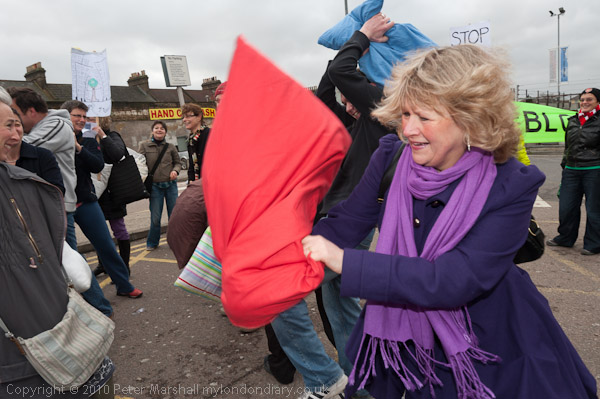
A pillowfight in the station car park
more pictures
Walthamstow residents staged a pillow fight in protest at plans for inappropriate high rise development on Walthamstow Central Station car park in advance of the council planning committee meeting next Thursday.
I don't often get invited to a public pillow fight in Walthamstow, and since it fitted in well with my schedule for Saturday - only 20 minutes on the Victoria line from where I wanted to be an hour later on Oxford St, I went along and took some pictures.
There was of course a serious story behind it, and just as at a previous time I visited Walthamstow it was about an unsuitable redevelopment in the centre of the town, but this time on the other side of the railway station, on the car park where the fight was taking place. A big banner read 'Stop the Blot' and placards said 'NO to Monster Development' and 'Blot It Out'.
The fight is over proposals by developers Solum Regeneration to build a 14 storey hotel and 8 storey blocks of flats there, which would tower over the surrounding area of largely late-Victorian low rise development. CABE, the Commission for Architecture and the Built Environment set up in 1999 to provide impartial advice to the government "on architecture, urban design and public space," condemned the scheme last year for its poor design and said it should be rejected. The small revisions made later by the developers increased the height of the hotel making it even less appropriate, and failed to address any of the local objections.
As well as the height of the development being out of keeping with the area, residents have also criticised the plans for failing to link with the town centre on the opposite side of the railway line, where the high street has what is often said to be the longest street market in Europe. They see it as designed to be a separate development for hotel guests and commuters who will take the trains out of the area rather than something that will contribute to the life of Walthamstow.
Solum Regeneration is a partnership between Network Rail and Kier Property to redevelop and make money out of the land surrounding railway stations in the South East, starting with seven sites: Epsom, Enfield, Maidstone East, Twickenham, Walthamstow, Wembley and Guildford, with West Brompton now added. So far on their web site they have come up with plans for Epsom, where work on site started last September (and has led to large protests against plans for night time working), Twickenham and Walthamstow Central.
The Twickenham scheme was condemned by residents there as being overbearing and inappropriate as well as worsening the problems caused by match day crowds and failing to improve access to the station. Last month Richmond Council Planning Committee deferred the planning application that Solum were trying to rush through for the podium over the railway lines which would support the development, agreeing with most of the resident's objections and refusing to consider it in isolation from the rest of the scheme. Solum had wanted to get on with the work so it could be completed for the 2019 Rugby World Cup, needing so much time as they are committed to avoid disruption to train services through the station taking visitors to Legoland in Windsor during the summer seasons, despite the extended disruption this will cause to local residents. The train service also brings large crowds to Staines for Thorpe Park throughout the summer.
Twickenham campaigners had a slight advantage in the very visible planning sore thumb of Regal House, an out of scale 1960s office block adjoining the proposed development and widely regarded as Twickenham's ugliest building. It was recently the subject of controversy over plans to turn it into a hotel, which although thrown out by the council were reinstated by Government’s planning inspectorate, adding a "carbunkle" to the mistake that should never have been allowed.
Solum are trying to push through things in even more of a rush in Walthamstow, where they want to have the hotel ready for the nearby 2012 Olympics. So far Waltham Forest appear to have conspired with them to cut corners on pushing this scheme through against local objections from groups including the Priory Avenue and Cedars Avenue Residents Association who organised the pillow fight as well as 'Fight The Height', a group set up to oppose a nearby town centre development by St Modwen. There may well be a case for judicial review should the plans be given the go-ahead.
The pillow fight involving around 50 adults and children was a spirited if
friendly affair, although a few feathers flew when one pillow was split. As
well as providing an opportunity for some general publicity about the scheme
it was timed to encourage all those opposed to the scheme to attend the Planning
Committee taking place on Thursday 20 Jan at the Town Hall on Forest Road,
for a demonstration as councillors arrive from 7pm and then to watch proceedings
from the public gallery.
more pictures
Solidarity With the Thessalonaki 4
Greek Embassy, Holland Park, London. Friday 14 Jan 2011
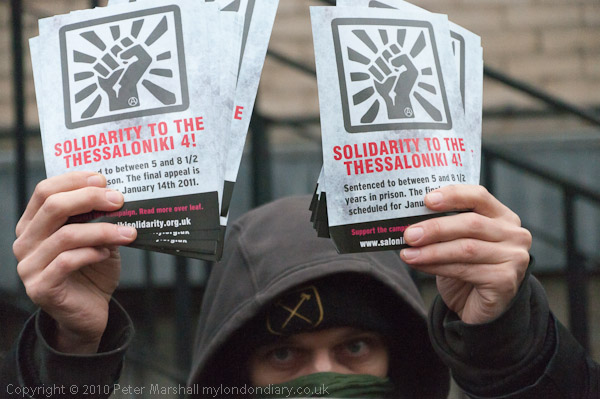
A masked protester holds up flyers about the protest at the Greek Embassy
more pictures
Evidence planted by police on the 4 protesters arrested after a demonstration in 2003 eventually led to their jailing in 2008. A demonstration at the Greek Embassy in London was held to mark the start of their appeal in the Greek courts.
Around twenty people, mainly dressed in black, turned up for the start of the protest, which was due to last three hours, and a few more were arriving as I left around half an hour later. Many of those taking part were keen to avoid being photographed and kept their heads down behind a large banner reading Solidarity to the Thessaloniki 4! The protest was organised by the London Thessaloniki Solidarity Group.
The Thessaloniki 4 were among a hundred people arrested following a demonstration at the EU summit held there in June 2003 - the slogan there was "No to the Europe of bankers and bosses". 29 were charged and Simon Chapman from Basildon was among the seven who were refused bail. A video, originally shown live on Greek TV shows his arrest, carrying a pale blue rucksack, and then confirms his evidence that the police planted two black rucksack on him full of Molotov cocktails. He was beaten by police until he agreed to pick it up and carry it, the bags were strapped to him ad his hands twisted and handcuffed behind his back. Photographs taken at the event confirm the switch of bags.
Months later, following a campaign with hundreds of demonstrations around the world and a hunger strike in which Chapman and four others had refused food for around 60 days, they were released in November 2003, and in Feb 2004 all charges were dropped because of the evidence that supported the defendents and the foreign protesters were allowed to leave Greece.
But the prosecution appealed and following two years of legal arguments there was a trial in January 2008 in which the defendants were found guilty and sentenced to between 5 and 8 ½ years each. Chapman had been advised by his lawyers it was not necessary to attend, which perhaps did not help in his defence.
These sentences were suspended until the appeal trial which was due to start for four of the original seven in September 2010, but was adjourned when police failed to produce one of the defendants who had been arrested on another charge. It was due to re-start today, Friday 14 January.
The trial is not just a trial for the four defendants - as well as Chapman
they are Souleiman “Kastro” Dakduk from Syria, Fernando Perez
Gorraiz from Spain, and Michalis Traikapis from Greece, but very much one
for the Greek justice system.
more pictures
Dance Against The Deficit Lies
Bank / Royal Exchange, London. Friday 14 Jan 2011
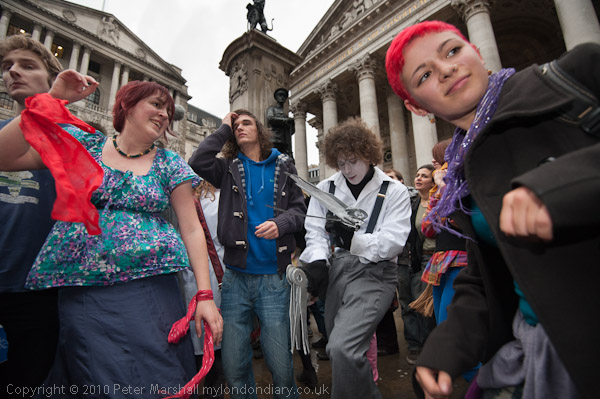 On
the left the Bank of England, right the Royal Exchange
On
the left the Bank of England, right the Royal Exchange
more pictures
Campaigners against cuts, particularly in the arts and community funding, danced for an hour at the Bank of England in a lively and entirely peaceful protest.
This was a rather different demonstration to previous protests against the savage cuts proposed by the coalition government to reduce the deficit. It hoped to get away from confrontation with the police, and the event was deliberately confined to a particular space and duration, a "dance off" involving "arts projects, community centres, dance groups and entertainers, " planned to last exactly an hour on the space in front of the Royal Exchange and facing the Bank of England.
It is a space with resonances for many protesters, where some of the worst excesses of police violence and over-reaction took place at the protests against the G20, and close to where Ian Tomlinson was attacked by a police officer and died.
It was also an appropriate place to protest about the cuts, made necessary by the excesses of the banks and the huge rescue package needed to bail them out, and to protest about their excessive salaries and indecent bonuses.
The organisers called for a protest that was "playful with purpose, (so) that any aggression whatsoever (police kettles or the tiny few protesters who throw stuff) will simply look preposterous." And on this occasion, unlike the G20 Carnival Against Capitalism, it remained playful, as instead of over-reacting the police simply stood back and enjoyed the spectacle.
It was a relatively small protest, with probably fewer than a hundred people taking part, many colourfully dressed, and almost as many spectators and photographers. Among those making a special effort to make the case against the cuts was indeed a walking suitcase (and at one point it became a dancing suitcase.) Several break dancers performed on the wet pavement, and of course there was music and dancing.
As the organisers point out, "the arts are one of the few things for which Britain is still revered around the world. We are good at it. It brings money in. Cuts to the arts are idiotic and short sighted."
The article which launched this protest asked why the levy on banks is being
reduced, and why the government is not imposing measures such as the Tobin
or Robin Hood tax on financial transactions that would not only being in much-needed
income to reduce the deficit but would provide a beneficial stability by dampening
speculation.
more pictures
London Solidarity With Tunisian Intifada
Tunisian Embassy, Kensington, London. Thursday 13 Jan 2011
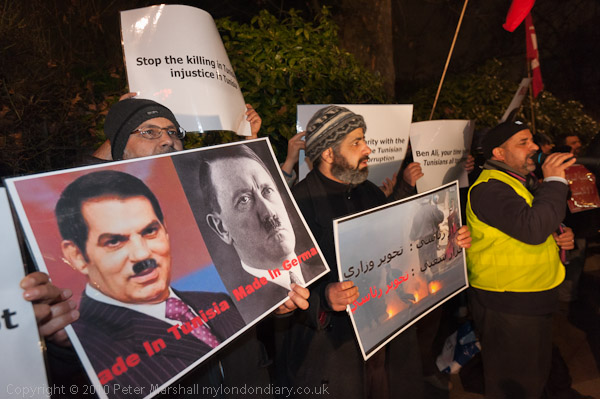
Made in Tunisia Made in Germany
more pictures
Protesters gathered opposite the Tunisian embassy in London this evening against the brutal repression of protests in Tunisia and in support of the Tunisian Intifada.
Anger at unemployment, corruption, rising food prices and social inequality
had led to large scale protests in Tunisia over the last month and on Wednesday
the government sent in troops to try to control the situation. A trigger for
the protests had been on December 17 when a 26 year old man committed suicide,
setting himself on fire after police had prevented him from making a living
by selling fruit and vegetables.
Police and troops have opened fire on protesters in several cities including
Tunis, and independent reports suggest that around 50 have died and many more
have been injured. Others have been arrested and tortured. A dusk to dawn
curfew is now being enforced in Tunis following violent protests on Wednesday,
and there are reports of more shooting today.
Tunisia has a long history of intolerance of dissent, with a large police force with a record of tight control through torturing and abusing. The UN High Commisioner for Human Rights Navanethem Pillay has urged Tunisa to investigate the killings by police and the allegations of torture.
On Wednesday, Tunisian president Zine al-Abidine Ben Ali dismissed the interior minister Rafik Belhaj Kacem, who was in charge of the police force and ordered the release of many of those arrested in earlier protests. There are also reports that the President has sacked some of his top advisers and the Army Chief of Staff who opposed the use of soldiers to put down the protests.
Although Tunisia has some of the trappings of democracy it is essentially a dictatorship supported by the USA. The Wikileaks cables included some damning condemnations of the regime by a former US ambassador, who detailed the repression their and the corruption of the ruling familes, going so far as to label the regime a "kepetocracy" for the way the two ruling families made use of the IMF/World Bank promoted privatisation to line their pockets with former public assets on the cheap.
Protests against the shooting and repression of dissent and calling for a complete reform of the government have taken place in Paris, Berlin and other European cities.
More than 50 people gathered opposite the Tunisian Embassy in Kensington,
London on Thursday night to support the Tunisian people, and what has become
to be called the Tunisian intifada. They called for an end to repression and
corruption, for freedom of expression and for President Ben Ali and his family
who have enriched themselves at the expense of the country to go.
more pictures
Close Guantánamo - Free Shaker Aamer
Trafalgar Square, London. Tuesday 11 Jan, 2011
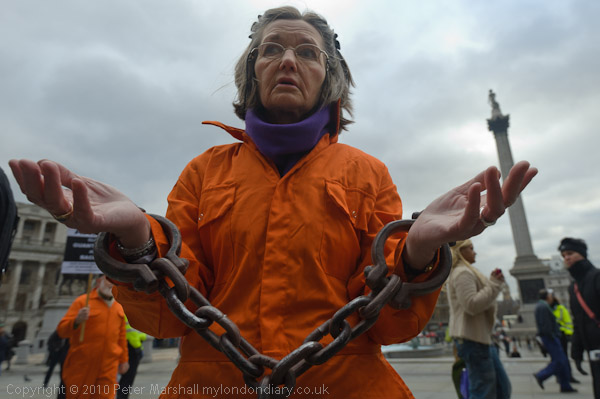
A woman in jump suit and chains protests in Trafalgar Square
more pictures
Campaigners marked the nine shameful years of illegal detention at Guantanamo Bay with a protest in Trafalgar Square, calling for the immediate release of London resident Shaker Amar.
The first 20 detainees arrived at Guantanamo Bay, the illegal US detention and torture camp on its military base on the island of CUba on Jan 11, 2002, nine years ago today. Sincve then more than 800 men have been illegally held there and despite the promise made by President Obama to close it down by January 2010, 173 men are still held there.
Few of that 800 have been tried in any way, and perhaps only one has had a fair trial. Many were just people who were found in the wrong place at the wrong time and had no connection with terrorism.
Among the 800 were 9 British nationals and 14 with the legal right to reside in the UK, and all but one of these has been released. The unfortunate man still there is a former London resident, Shaker Aamer, who has been held there since 2002.
When Shaker was 17, he ran away from a cruel stepmother in Saudi Arabia to join friends in the USA. Later he travelled around the Middle East and Europe, meeting the British woman who became his wife in London, where they were married and settled in Battersea south London, where their first child was botn in 1999.
Shaker started working as an Arabic translator for the solicitor who had advised him on his immigration , and in June 2001 went to work in Kabul for an Islamic charity.
Three months later, after the bombing in Kabul started, he was arrested by soldiers, and beaten by them for two weeks. Then he was transferred to US forces and subjected to several months of torture at Bagram Airforce base. He lost 60 lbs in weight, his feet were frostbitten from exposure to the winter conditions, freezing water was poured over him, he was chained up for hours in agonising positions, beaten, deprived of sleep and beaten. Eventually he signed a number of false confessions, after which he was transferred to Guantánamo.
There he tried to help his fellow prisoners and was branded a ringleader when some when on hunger strike. He was placed in solitary confinement in a small windowless cell and has now been there for more than five years.
He has now officially been cleared of terrorist offences and has been cleared for release, but is still being held. Although UK governments have sought his release, it could cause considerable political embarrasment both in the USA and here, as an MI6 officer was apparently present during some of his torture.
Around 50 people from the London Guantánamo Campaign turned up for a protest in Trafalgar Square, where many of them dressed in bright orange Guantánamo-style jump suits. Some of them wore the sinister black hoods familiar from some of the photographs taken by US troops of torture victims, and one was in chains as used to confine prisoners.
A group stood in line with letters in front of the National Gallery, spelling out the simple message, 'SHUT GUANTANAMO', and there were a few short speeches.
Earlier in the day a letter, signed by 75 prominent figures and on behalf
of a number of organisations was handed in to 10 Downing St (and a shortened
version printed in the Guardian) askgin for PM David Cameron to to take immediate
action to secure the release and return to the UK of Shaker Aamer, seek the
release of other prisoners to the UK on humanitarian grounds and help the
US close Guantánamo Bay. Among those who signed it were MPs Caroline
Lucas and John McDonnell, MEPs Jean Lambert and Baroness Sarah Ludford, London
Assembly Member Darren Johnson, Bruce Kent, Victoria Brittain, Andy Worthington,
Lindsey German and Kate Hudson.
more pictures
Party Against the Cuts
Trafalgar Square to Cowley St, London. Friday 7 Jan 2011
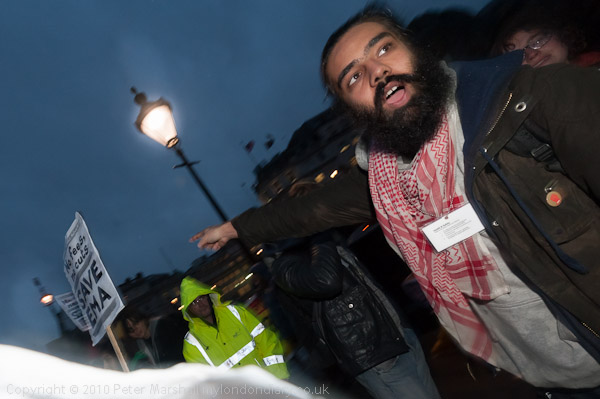
Time to march to the Lib Dem HQ!
more pictures
Student protesters met at Trafalgar Square and marched peacefully down Whitehall and through Parliament Square to the Lib Dem HQ, where they delivered two kettles as a birthday present for Nick Clegg in protest against his support of tuition fees and cuts.
Around a hundred people, mainly students, some carrying kettles and others with party hats as well as placards met in the rain as darkness fell in Trafalgar Square. The numbers were disappointing as more than a thousand had indicated on Facebook that they would attend, with another almost 700 saying 'maybe' they would come. Possibly the poor weather with heavy showers had put many off - and after all there are plenty of other opportunities to demonstrate against the cuts and fees in the next few weeks and months.
The 'Party Against the Cuts' was called by a group of students on Facebook and supported by the Education Activist Network whose banner led the protest. Several people spoke at Trafalgar Square including people from several of the student occupations and poet Lemn Sissay performed one of his works, I think 'Crowd Control' written in the 1990s but still very relevant to the current situation.
The event was a party for Nick Clegg's birthday, and reflected the particular scorn and sense of betrayal felt towards him and the other Lib Dem members of the coalition government because of the U-turn they made over student fees, as well as their support of draconian cuts in public services rather than arguing for ways of reducing the deficit that don't discriminate against the less wealthy - such as tightening up on tax frauds and loopholes used by the rich.
The police talked to some of those organising the protest, and an officer walked in front leading the way to the Lib Dem HQ in Cowley St, which had been blocked off with barriers. The protesters gathered in front of these, with a line of police keeping them from wandering into the road behind, but there was no attempt at full containment (kettling) while I was there.
The protesters chanted, sang 'Happy Birthday' and there were some short speeches, along with the blowing of party whistles and waving of kettles. Three of them were then allowed through the barriers to present two kettles, decorated with slogans, as a birthday present to a man - not Mr Clegg - who came out from the building to receive them. Others inside the Lib Dem HQ watched through the windows, though moved away when they saw the photographers had noticed them.
I left as it seemed that the protest was coming to an end and other people
were beginning to drift away. The protest had remained peaceful throughout,
and the only dispute I saw was when a photographer objected to being roughly
pushed by the police when a polite request to move would have been more appropriate.
Earlier the marchers had sensibly ignored the police request to walk on the
pavement at the top of Whitehall (it isn't wide enough, has multiple obstructions
and is full of tourists) and the police had sensibly not tried to enforce
it. After going through Parliament Square the march did proceed largely along
the pavement behind a police officer, perhaps because he was probably the
only person who knew where the Lib Dem HQ is!
more pictures
Staines Walk
Staines, Middx. Monday 3 Jan 2011
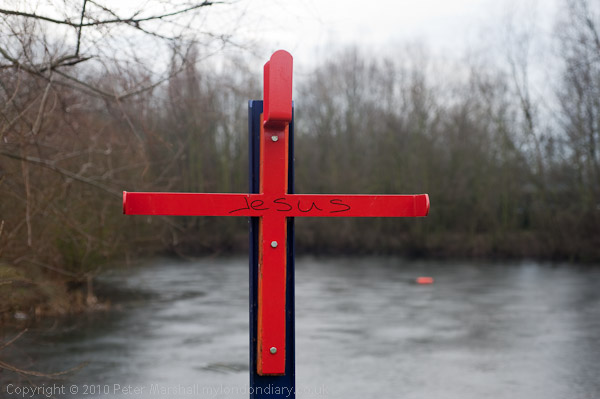
The missing lifebelt is out on the ice. Unfilled gravel
pits on Staines Lammas landscaped as a 'nature reserve'
more pictures
We seemed to have a very long break over Christmas and the New Year, longer than normal because as Christmas and New Year fell on Saturdays we had the usual bank holidays not then but on the following Monday (and Tuesday for Boxing Day.) On this one we went for a guided walk around Staines. As well as the leader we also had several others on the walk who have researched various aspects of local history, so there were a few things to be learnt.
Staines was an important place for early human occupation, and we walked close to one of the more important sites. Unfortunately most of the local sites of interest were either destroyed by gravel raising or, as in this case for the construction of the M25 junction. Similarly, although it was an important Roman settlement, little of this has been explored, though local legend says that when they were building the foundations for our major department store the workmen found what looked like a major Roman building and were ordered to pour the concrete in quickly before anyone else noticed. The Romans built bridges at Staines (Ad Pontes) but we don't know where, though the most likely site is near the parish church where Church Island is rather than close to the current bridge.
Our route took us on to Staines Moor, an ancient common and an SSSI, although much of its ancient turf was damaged by the treatment given it after the flooding a couple of years back. The 'Lord of the Manor' who owns it is a large gravel company, though allegedly they have no interest in digging it up for gravel - though much of the surrounding land has already been dug.
Staines Moor is currently under threat from Airtrack, a proposed rail link through Staines to London Heathrow, which would also seriously threaten existing rail services through Staines and condemn traffic in Egham to almost perpetual gridlock. It seems likely to be completed around the time we finally get round to officially recognising that Heathrow needs to be pensioned off on environmental grounds.
There used to be a railway along the edge of Staines Moor, a branch line from West Drayton down to Staines West station. After Beeching cut that service, parts of it remained in use for goods both at the north end down as far as Colnbrook, and also a small section in Staines that was then linked to the Staines-Windsor line to serve a small oil terminal - which is now a housing estate. The northern part of this could be extended for use as as a part of a Heathrow rail link from Reading and the west.
We also climbed what was the only hill in Staines, a man made lump on the moor built to stop the bullets when the moor was used as a rifle range (and there was a much larger firing range on the other side of Moor Lane, now under the M25 and the Wraysbury reservoir. From its top we could see some newer hills, landfill after gravel raising around Stanwell Moor, though earlier we have walked through a 'nature reserve', probably a cheap method for gravel companies to avoid having to fill in pits after extraction.
On Staines Moor we walked by Staines's second river, the Colne which actually
flows through Staines in several streams, once used for mills - they include
the Wraysbury River and River Ash (and used to include Bonehead Ditch which
runs at the end of my back garden but for which water is now raised by a pump
on the Thames in Staines after its old course was blocked during the town
centre redevelopment.)
more pictures
top of page
All pictures on this section of the site are Copyright © Peter Marshall 2011; to buy prints or for permission to reproduce pictures or to comment on this site, or for any other questions, contact me.

